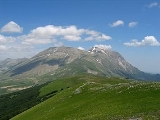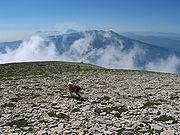
Monte Vettore
Encyclopedia
Monte Vettore is a mountain
on the border between Umbria
and the Marche
, in central Italy
. It is part of the Sibillini mountains range and lies in the Parco Nazionale dei Monti Sibillini
. Today climbers reach it from the Umbrian side from Norcia
, or, on the Marche side, from Ascoli Piceno
. Below the peak, in a small enclosed valley is one lake called the Lago di Pilato, at an altitude of 1,940 metres, where, according to the local medieval legend, the body of a remorseful Pontius Pilate was buried in the waters. A similar legend is told of Mons Pilatus in Switzerland.
The local medieval tradition was that the Apennine Sibyl, a mysterious prophetess not counted among the Sibyl
s of Classical Antiquity
, was condemned by God to dwell in a mountain cavern, awaiting Judgement Day, having rebelled at the news that she had not been chosen Mother of God, but that some humble Judaean virgin had been favored. The peak of Monte Vettore, surrounded by reddish cliffs was recognized as the crown of Regina Sibilla.
 Less stringently Christian legend set her in an underworld paradise entered through a grotto in the mountains of Norcia. Nearby the magical lake is fed by water from the cavern. Whoever stayed longer than a year could no longer leave, but remained deathless and ageless, feasting in abundance, amid revelry and voluptuous delights.
Less stringently Christian legend set her in an underworld paradise entered through a grotto in the mountains of Norcia. Nearby the magical lake is fed by water from the cavern. Whoever stayed longer than a year could no longer leave, but remained deathless and ageless, feasting in abundance, amid revelry and voluptuous delights.
In the romance
of Il Guerrin Meschino
, written by Andrea da Barberino
about 1410, the central episode of the sixth part (Canto V) contains the "prodigious adventures" of Guerrino with this enchantress, the "Fata" Alcina, whom he seeks out, against all advice. He locates her cavern in the mountains of central Italy with the aid of Macco, a speaking serpent. She shows him the delights and horrors of her cavern, where sinners have been changed to the appropriate animals, but where sin is the only path to the knowledge of his real parents that he seeks, and Guerrin has to flee.
The long informative captions in the maps of Ortelius' 16th century atlas, Cartographia Neerlandica, offer some detail about this Apennine Sybil:
Locally the Sibilla was in some sense a beneficent fata
whose retinue would descend from her mountain at times to teach the village girls all the secrets of spinning and weaving (see Weaving (mythology)
for other European weaving goddesses), and perhaps to dance the saltarello
with the best of the young men. But if they weren't back in their mountain fastness by sunrise, they would be denied access and would become mere mortals. On one occasion, what with dancing and pleasure, the faterelle had not noticed the approach of dawn. Scrambling up the Vettore, their goatlike feet crushed the rock to fragments. They reached the safety of their grotto just before dawn, but the long slope of talus
is still pointed out as the Path of the Fata.
Mountain
Image:Himalaya_annotated.jpg|thumb|right|The Himalayan mountain range with Mount Everestrect 58 14 160 49 Chomo Lonzorect 200 28 335 52 Makalurect 378 24 566 45 Mount Everestrect 188 581 920 656 Tibetan Plateaurect 250 406 340 427 Rong River...
on the border between Umbria
Umbria
Umbria is a region of modern central Italy. It is one of the smallest Italian regions and the only peninsular region that is landlocked.Its capital is Perugia.Assisi and Norcia are historical towns associated with St. Francis of Assisi, and St...
and the Marche
Marche
The population density in the region is below the national average. In 2008, it was 161.5 inhabitants per km2, compared to the national figure of 198.8. It is highest in the province of Ancona , and lowest in the province of Macerata...
, in central Italy
Italy
Italy , officially the Italian Republic languages]] under the European Charter for Regional or Minority Languages. In each of these, Italy's official name is as follows:;;;;;;;;), is a unitary parliamentary republic in South-Central Europe. To the north it borders France, Switzerland, Austria and...
. It is part of the Sibillini mountains range and lies in the Parco Nazionale dei Monti Sibillini
Parco Nazionale dei Monti Sibillini
thumb|280px|A view of [[Monte Sibilla]].The Parco Nazionale dei Monti Sibillini is an Italian national park located across the regions of Marche and Umbria, encompassing the provinces of Macerata, Fermo, Ascoli Piceno and Perugia.It was established in 1993, and now contains more than 70,000...
. Today climbers reach it from the Umbrian side from Norcia
Norcia
Norcia is a town and comune in the province of Perugia in southeastern Umbria, located in a wide plain abutting the Monti Sibillini, a subrange of the Apennines with some of its highest peaks, near the Sordo River, a small stream that eventually flows into the Nera...
, or, on the Marche side, from Ascoli Piceno
Ascoli Piceno
Ascoli Piceno is a town and comune in the Marche region of Italy, capital of the province of the same name. Its population is c. 51,400.-Geography:...
. Below the peak, in a small enclosed valley is one lake called the Lago di Pilato, at an altitude of 1,940 metres, where, according to the local medieval legend, the body of a remorseful Pontius Pilate was buried in the waters. A similar legend is told of Mons Pilatus in Switzerland.
The local medieval tradition was that the Apennine Sibyl, a mysterious prophetess not counted among the Sibyl
Sibyl
The word Sibyl comes from the Greek word σίβυλλα sibylla, meaning prophetess. The earliest oracular seeresses known as the sibyls of antiquity, "who admittedly are known only through legend" prophesied at certain holy sites, under the divine influence of a deity, originally— at Delphi and...
s of Classical Antiquity
Classical antiquity
Classical antiquity is a broad term for a long period of cultural history centered on the Mediterranean Sea, comprising the interlocking civilizations of ancient Greece and ancient Rome, collectively known as the Greco-Roman world...
, was condemned by God to dwell in a mountain cavern, awaiting Judgement Day, having rebelled at the news that she had not been chosen Mother of God, but that some humble Judaean virgin had been favored. The peak of Monte Vettore, surrounded by reddish cliffs was recognized as the crown of Regina Sibilla.

In the romance
Romance (genre)
As a literary genre of high culture, romance or chivalric romance is a style of heroic prose and verse narrative that was popular in the aristocratic circles of High Medieval and Early Modern Europe. They were fantastic stories about marvel-filled adventures, often of a knight errant portrayed as...
of Il Guerrin Meschino
Il Guerrin Meschino
Il Guerrin Meschino is an Italian prose chivalric romance with some elements of verisimilitude, written by the Tuscan trovatore and systematizer and translator from French, Andrea da Barberino, who completed it about 1410....
, written by Andrea da Barberino
Andrea da Barberino
Andrea Mangiabotti, called Andrea da Barberino was an Italian writer and cantastorie of the Quattrocento Renaissance. He was born in Barberino di Val d'Elsa and lived in Florence...
about 1410, the central episode of the sixth part (Canto V) contains the "prodigious adventures" of Guerrino with this enchantress, the "Fata" Alcina, whom he seeks out, against all advice. He locates her cavern in the mountains of central Italy with the aid of Macco, a speaking serpent. She shows him the delights and horrors of her cavern, where sinners have been changed to the appropriate animals, but where sin is the only path to the knowledge of his real parents that he seeks, and Guerrin has to flee.
The long informative captions in the maps of Ortelius' 16th century atlas, Cartographia Neerlandica, offer some detail about this Apennine Sybil:
Locally the Sibilla was in some sense a beneficent fata
Fairy
A fairy is a type of mythical being or legendary creature, a form of spirit, often described as metaphysical, supernatural or preternatural.Fairies resemble various beings of other mythologies, though even folklore that uses the term...
whose retinue would descend from her mountain at times to teach the village girls all the secrets of spinning and weaving (see Weaving (mythology)
Weaving (mythology)
The theme of weaving in mythology is ancient, and its lost mythic lore probably accompanied the early spread of this art. In traditional societies today, westward of Central Asia and the Iranian plateau, weaving is a mystery within woman's sphere...
for other European weaving goddesses), and perhaps to dance the saltarello
Saltarello
The saltarello was a lively, merry dance first mentioned in Naples during the 13th century. The music survives, but no early instructions for the actual dance are known. It was played in a fast triple meter and is named for its peculiar leaping step, after the Italian verb saltare .-History:The...
with the best of the young men. But if they weren't back in their mountain fastness by sunrise, they would be denied access and would become mere mortals. On one occasion, what with dancing and pleasure, the faterelle had not noticed the approach of dawn. Scrambling up the Vettore, their goatlike feet crushed the rock to fragments. They reached the safety of their grotto just before dawn, but the long slope of talus
Scree
Scree, also called talus, is a term given to an accumulation of broken rock fragments at the base of crags, mountain cliffs, or valley shoulders. Landforms associated with these materials are sometimes called scree slopes or talus piles...
is still pointed out as the Path of the Fata.
External links
- Cartographica Neerlandica: Text for Ortelius' map No. 137
- Romance of Guerrin il Meschino, Part Six (abstract in modern Italian).
- Parco Nazionale dei Monti Sibillini
- Cooperation Network for European Culture Ascoli Piceno. Casual reference to the Pontius Pilate connection.
- Monique Bouquet and Françoise Morzadec, 2004. La Sibylle: Parole et représentation. Collection "Interférences". (Rennes: Presses Universitaires de Rennes) discusses Antoine de la SaleAntoine de la SaleAntoine de la Sale or la Salle was a French writer.-Family and Early Years:He was born in Provence, probably at Arles, the illegitimate son of Bernardon de la Salle, a celebrated Gascon mercenary, mentioned in Froissart's Chronicles. His mother was a peasant, Perrinette Damendel.-At the Court of...
's Paradis de la Reine Sibylle.

